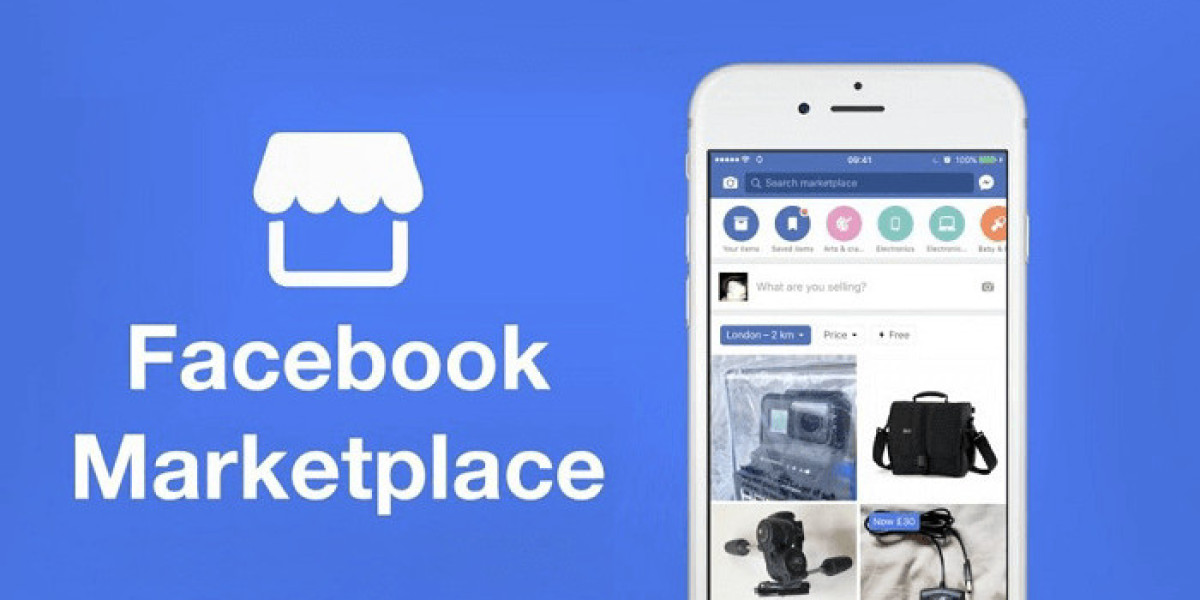The digital age has transformed the way we conduct business, making buying and selling more accessible, efficient, and global. Gone are the days when transactions were limited to physical stores or reliant on word-of-mouth promotions.
Today, with just a few clicks, businesses can reach customers from different parts of the world, and consumers can find almost anything they desire online.
Enter Facebook Marketplace, a platform that has quickly risen to prominence in the e-commerce world. Launched by the social media behemoth, Facebook, this platform combines the power of social networking with commerce, offering a unique space for businesses and consumers to interact.
With its user-friendly interface, vast user base, and integrated tools, Facebook Marketplace provides businesses, both big and small, an opportunity to tap into a ready market.
For businesses, this isn't just another platform to list their products. It's a space where they can build their brand, engage with their audience, and drive sales in a more personalized manner. The informal setting of Facebook allows businesses to break down the traditional barriers of commerce, fostering trust and building long-lasting relationships with their customers.
In essence, Facebook Marketplace isn't just a selling platform; it's a new frontier for businesses, offering unparalleled opportunities to grow, engage, and succeed in the digital age.
Understanding the Power of Facebook Marketplace
With over 2.8 billion monthly active users, Facebook stands as the world's most extensive social media network. This vast user base offers an unparalleled audience for businesses, making Facebook Marketplace a potent tool for commerce.
Every day, millions of users browse the Marketplace, looking for products, services, and deals, presenting businesses with a golden opportunity to showcase their offerings to a diverse and engaged audience.
But what truly sets Facebook Marketplace apart is its seamless integration within the broader Facebook ecosystem. Unlike standalone e-commerce platforms, Marketplace benefits from the social interactions that are native to Facebook.
This means that businesses aren't just listing products; they're telling stories, building communities, and engaging with customers in real-time. A product listing can be shared, liked, commented on, and even become a topic of discussion among friends, amplifying its reach and impact.
Furthermore, the data-driven nature of Facebook allows for advanced targeting. Businesses can leverage Facebook's vast data resources to reach specific demographics, ensuring that their products are seen by those most likely to be interested. Whether targeting by age, location, interests, or behaviors, the precision offered is unparalleled.
Additionally, the integration extends to other Facebook-owned platforms like Instagram, providing businesses with cross-platform promotional opportunities. A product listed on Marketplace can be showcased through Instagram stories, or an ad campaign can run simultaneously on both platforms, creating a cohesive and unified brand presence.
In essence, the power of Facebook Marketplace lies not just in its vast user base but in its ability to integrate commerce within the social fabric of Facebook. For businesses, this means more than just sales; it's about building relationships, understanding customers, and growing organically within the world's largest social media network.
Setting Up Your Business on Marketplace
Establishing a presence on Facebook Marketplace begins with setting up a business profile that stands out and resonates with potential customers. A business profile is more than just a digital storefront; it's a reflection of your brand's identity, values, and offerings.
Creating a Compelling Business Profile:
- Profile Picture and Cover Photo: Use high-quality images that represent your brand. The profile picture could be your business logo, while the cover photo can showcase your products, services, or a promotional campaign.
- Business Details: Ensure all details, such as business name, address, contact information, and operating hours, are accurate and up-to-date.
- About Section: Craft a concise yet engaging description of your business. Highlight what sets you apart, your mission, and what customers can expect.
- Customer Reviews: Encourage satisfied customers to leave positive reviews. This not only builds trust but also provides valuable feedback.
- Interactive Elements: Utilize features like call-to-action buttons (e.g., "Shop Now" or "Contact Us") to guide potential customers towards desired actions.
Listing Your Products: Best Practices:
- High-Quality Images: Use clear, well-lit photos that showcase the product from multiple angles. If possible, include images of the product being used to give customers a better understanding.
- Detailed Descriptions: Be thorough and honest in your product descriptions. Highlight key features, specifications, and any unique selling points. Avoid jargon and ensure the information is easily understandable.
- Pricing: Set competitive prices based on market research. If offering a discount or promotion, highlight it to attract more attention.
- Product Categories: Ensure products are listed in the correct categories to make them easily discoverable by potential customers.
- Inventory Management: Regularly update product availability. If an item is out of stock, mark it as such or remove the listing to avoid customer disappointment.
- Engage with Questions: Potential buyers may have questions or need clarifications. Respond promptly and professionally to inquiries to build trust and increase the likelihood of a sale.
By meticulously crafting a compelling business profile and adhering to best practices when listing products, businesses can optimize their presence on Facebook Marketplace, attracting more customers and driving sales.
Optimizing Product Listings for Maximum Impact
Crafting Attention-Grabbing Titles:
- Be Descriptive: The title should give a clear idea of what the product is. Instead of just "shoes," specify "Women's Red High-Heeled Shoes."
- Use Relevant Keywords: Incorporate keywords that potential buyers might use in their search. This enhances the product's visibility in search results.
- Avoid Clickbait: While it's essential to grab attention, ensure the title accurately represents the product. Misleading titles can lead to mistrust and reduced engagement.
- Limit Special Characters: Overusing symbols or caps can make a title look spammy. Keep it clean and straightforward.
Using High-Quality Images and Detailed Descriptions:
- Clear and Bright Images: Ensure photos are well-lit and clear. Blurry or dark images can deter potential buyers.
- Multiple Angles: Showcase the product from various angles to give a comprehensive view. For instance, if selling a bag, show the front, back, inside, and perhaps a photo with someone wearing it.
- Contextual Photos: Where relevant, show the product in use. This helps buyers visualize its utility.
- Detailed Descriptions: Go beyond basic specifications. Highlight unique features, brand history, or any warranties. The more information you provide, the more confident a buyer will feel.
- Use Bullet Points: For easy readability, list out key features or specifications using bullet points.
Pricing Strategies for Competitive Edge:
- Market Research: Regularly check competitor prices to ensure you're not pricing too high or too low.
- Dynamic Pricing: Adjust prices based on demand, stock levels, or upcoming sales events.
- Bundle Offers: Offer discounts for buying in bulk or bundling complementary products together.
- Transparent Pricing: Ensure there are no hidden costs. If shipping is extra, state it clearly.
- Price Anchoring: Display the original price slashed out next to the discounted price. This gives buyers a sense of the deal they're getting.
By optimizing product listings, businesses can significantly enhance their visibility on Facebook Marketplace, attract more potential buyers, and increase the likelihood of successful sales.
Engaging with Potential Customers
Utilizing Instant Messaging for Real-Time Communication:
- Active Presence: Ensure you're online during peak hours or times when your target audience is most active. This allows for immediate engagement with potential customers.
- Personalized Interactions: While it's tempting to use automated responses, personalized replies can make a significant difference. Addressing customers by their names and tailoring responses to their queries can foster a more personal connection.
- Use of Multimedia: Don't just rely on text. Share product videos, user testimonials, or additional photos through instant messaging to provide a comprehensive understanding of your product.
- FAQs: Anticipate common questions and have ready answers. This not only speeds up the response time but also showcases your expertise and preparedness.
Building Trust through Transparency and Prompt Responses:
- Honesty is Key: Always be truthful about product details, pricing, and availability. If there's a delay in shipping or any other issue, communicate it proactively. Customers appreciate honesty, even if the news isn't always positive.
- Promptness: Time is of the essence in online transactions. Responding quickly to inquiries can be the difference between making a sale and losing a potential customer. Even if you don't have an immediate answer, acknowledging the query and providing a timeframe for a detailed response can be beneficial.
- Encourage Reviews: After a successful transaction, encourage customers to leave reviews. Positive reviews can significantly boost your credibility on the platform.
- Handle Criticism Gracefully: If faced with negative feedback or a complaint, address it professionally. Apologize if necessary, offer solutions, and ensure the customer feels heard and valued. This not only helps in damage control but can also turn a disgruntled customer into a loyal one.
- Transparency in Transactions: Clearly outline payment methods, return policies, and any other pertinent transaction details. The more transparent you are, the more trust you build with potential customers.
Engaging effectively with potential customers is more than just making a sale; it's about building lasting relationships. By ensuring real-time communication and fostering trust, businesses can create a loyal customer base, leading to repeat sales and positive word-of-mouth referrals.
Promotion and Marketing Strategies
Leveraging Facebook Ads to Boost Listings:
- Targeted Advertising: Facebook's ad platform allows businesses to target specific demographics based on interests, behaviors, location, and more. This ensures your listings reach the most relevant audience.
- A/B Testing: Experiment with different ad creatives, headlines, and call-to-action buttons to determine which combinations drive the most engagement and conversions.
- Budget Optimization: Set daily or lifetime budgets for your ads and use Facebook's automatic optimization tools to get the most bang for your buck.
- Carousel Ads: Showcase multiple products or highlight different features of a single product using carousel ads. This format allows users to scroll through multiple images or videos within a single ad.
Using Retargeting to Re-Engage Potential Customers:
- Pixel Integration: By integrating the Facebook Pixel on your website, you can track visitors and their actions. This data allows you to retarget those who showed interest but didn't make a purchase.
- Dynamic Ads: Automatically promote products to people who have expressed interest on your website, in your app, or elsewhere on the Internet.
- Segmentation: Create specific ad campaigns targeting users based on their interactions, such as those who added products to the cart but didn't check out.
Collaborating with Influencers or Popular Facebook Groups:
- Influencer Partnerships: Identify influencers whose audience aligns with your target demographic. Collaborate on promotional content, from reviews to unboxing videos, to tap into their follower base.
- Engage in Groups: Join popular Facebook groups related to your industry or product niche. Engage in discussions, offer expert advice, and subtly promote your listings without being overly salesy.
- Create Your Own Group: Establish a community around your brand or products. This not only serves as a platform for promotions but also fosters loyalty and encourages user-generated content.
- Cross-Promotions: Partner with complementary businesses or brands on Facebook to co-promote each other. This can expand your reach to a new set of potential customers.
By implementing these promotion and marketing strategies, businesses can amplify their presence on Facebook Marketplace, driving more traffic to their listings and increasing the likelihood of sales.
Safety and Trust: Building a Reliable Brand Image
Ensuring Secure Transactions:
- Transparent Payment Methods: Clearly outline the payment methods you accept, whether it's direct bank transfers, electronic payment gateways, or cash on delivery. This sets clear expectations for the buyer.
- SSL Certificates: If you're directing customers to your website for payment, ensure it's SSL certified. This encryption protects sensitive information and assures buyers that their data is secure.
- Avoiding Advance Payments: Especially for high-value items, consider using escrow services or COD (Cash On Delivery) to ensure both parties are protected during the transaction.
Gathering and Showcasing Positive Reviews and Testimonials:
- Encourage Feedback: After a successful transaction, prompt customers to leave a review. Their feedback not only helps improve your service but also builds credibility.
- Highlight Positive Testimonials: Showcase positive reviews prominently, whether on your Facebook page, website, or even within product listings. Potential buyers often look for reviews to gauge reliability.
- Engage with Reviews: Respond to reviews, both positive and negative. Thanking customers for positive feedback and addressing any concerns in negative reviews shows you value customer input and are committed to continuous improvement.
Handling Disputes Professionally:
- Open Dialogue: If a customer raises a concern or dispute, engage in open communication. Listen to their grievances and work towards a mutually beneficial resolution.
- Clear Return and Refund Policies: Clearly outline your return and refund policies. This not only sets clear expectations but also provides a reference point in case of disputes.
- Mediation Services: In rare cases where disputes can't be resolved directly, consider using third-party mediation services to arrive at a fair resolution.
- Learning from Disputes: Every dispute provides an opportunity to learn and improve. Analyze the root cause and implement changes to prevent similar issues in the future.
Building a reliable brand image on Facebook Marketplace goes beyond just making sales. It's about establishing trust, ensuring safety, and fostering long-term relationships with customers. By prioritizing secure transactions, showcasing positive feedback, and handling disputes professionally, businesses can create a strong and trustworthy presence in the online marketplace.
Analyzing and Adapting: Using Insights for Growth
Tracking Performance Metrics:
- Engagement Rates: Monitor the number of views, likes, shares, and comments on your listings. High engagement often indicates that your product resonates with the audience.
- Conversion Rates: Measure the percentage of users who take a desired action, such as making a purchase after viewing a listing. A low conversion rate might indicate a need to tweak the product description, images, or pricing.
- Click-Through Rates (CTR): If you're using Facebook Ads to promote your listings, CTR will show how often people click on your ad after seeing it. A low CTR might suggest that your ad imagery or copy isn't compelling enough.
- Sales Metrics: Track the number of sales, average transaction value, and total revenue. These metrics provide a direct insight into the financial health of your business on the platform.
Adapting Strategies Based on Feedback and Trends:
- Customer Feedback: Regularly solicit feedback from customers. Their insights can highlight areas of improvement, whether it's in product quality, description accuracy, or communication.
- Market Trends: Stay updated with current market trends. If a particular product category is gaining popularity, consider adding it to your listings. Conversely, if a product isn't performing well, it might be time to phase it out or adjust its presentation.
- Competitor Analysis: Regularly check out competitors on Facebook Marketplace. Analyze their product listings, prices, and customer reviews to identify areas where you can differentiate and offer better value.
- Seasonal Adaptations: Adjust your listings based on seasons or upcoming holidays. For instance, promoting winter wear during colder months or offering special discounts during festive seasons can drive more sales.
- Iterative Testing: Regularly test different aspects of your listings, from images to product descriptions. By comparing performance metrics for different versions, you can identify which elements resonate most with your audience.
In the dynamic world of online marketplaces, success often hinges on the ability to analyze and adapt. By closely tracking performance metrics and being responsive to feedback and market trends, businesses can continuously refine their strategies, ensuring sustained growth and success on Facebook Marketplace.
Expanding Beyond the Local: Reaching a Global Audience
Utilizing Shipping Options for Broader Reach:
- Offering Multiple Shipping Options: Provide a range of shipping methods, from standard to express, to cater to various customer needs. This flexibility can attract a wider range of buyers.
- Partnering with Reliable Couriers: Collaborate with reputable shipping companies known for timely and safe deliveries. This ensures that your products reach international customers in good condition.
- Transparent Shipping Costs: Clearly outline shipping fees, especially for international deliveries. Consider offering free shipping for orders above a certain value to incentivize larger purchases.
- Handling Customs and Duties: For international shipments, be aware of customs regulations and duties. Provide necessary documentation and consider including an estimate of potential customs fees in your product listings.
Tailoring Listings for Different Demographics:
- Cultural Sensitivity: When selling to a global audience, be mindful of cultural differences. Ensure that your products and listings are appropriate and appealing to diverse cultures.
- Language Options: Consider providing translations of your product descriptions in major languages. This makes your listings more accessible to non-English speaking customers.
- Local Currency Pricing: Display product prices in the local currency of the target market. This simplifies the buying process for international customers and can boost sales.
- Highlighting International Bestsellers: If certain products are particularly popular in specific regions, highlight them in your listings for those demographics.
- Gathering International Reviews: Encourage feedback from international buyers. Positive reviews from diverse customers can build trust with potential buyers from those regions.
Reaching a global audience on Facebook Marketplace requires a combination of logistical planning and cultural awareness. By offering flexible shipping options and tailoring listings to resonate with different demographics, businesses can tap into the vast potential of the international market, expanding their customer base and boosting sales.
Conclusion
Embracing the Future of Business on Facebook Marketplace:
- Digital Transformation: As the world continues to shift towards online platforms, Facebook Marketplace emerges as a significant player in the e-commerce landscape. Businesses that leverage this platform position themselves at the forefront of this digital revolution.
- Community Building: Beyond just transactions, Facebook Marketplace offers businesses the opportunity to build a community. Engaging with customers, receiving feedback, and fostering loyalty can lead to long-term relationships and repeat business.
Continuous Learning and Adaptation for Sustained Growth:
- Staying Updated: The digital marketplace is ever-evolving. Regularly updating product listings, revisiting pricing strategies, and keeping abreast of platform changes ensures that businesses remain competitive.
- Feedback Loop: Actively seeking and acting upon customer feedback is crucial. It not only helps in refining the product offerings but also in enhancing the overall customer experience.
- Diversification: While Facebook Marketplace is a powerful platform, businesses should also consider diversifying their online presence. Exploring other e-commerce platforms, building a standalone website, or leveraging other social media channels can provide multiple avenues for growth.
- Innovation: The online marketplace is ripe for innovation. Whether it's through unique product offerings, creative marketing strategies, or leveraging emerging technologies like AR (Augmented Reality) for product displays, businesses that innovate set themselves apart.
In conclusion, Facebook Marketplace presents a golden opportunity for businesses to tap into a vast and engaged audience. However, success on this platform requires more than just listing products. It demands a proactive approach, a commitment to continuous learning, and the flexibility to adapt to changing market dynamics. By embracing these principles, businesses can harness the full potential of Facebook Marketplace and chart a path to sustained growth.
How do I attract customers to my Facebook Marketplace?
- Use high-quality images for your listings.
- Provide detailed and accurate product descriptions.
- Price items competitively based on market research.
- Respond promptly to inquiries.
- Gather and showcase positive reviews from past buyers.
Can Facebook Marketplace be used for business?
Yes, both individuals and businesses can use Facebook Marketplace to sell items. However, businesses especially can benefit from the platform's vast user base to promote their products.
What makes the most profit on Facebook Marketplace?
High-demand items, unique or handcrafted goods, and products priced competitively tend to yield higher profits. It also depends on the region and the target audience.
How do I receive payment from Facebook Marketplace?
Facebook Marketplace allows users to arrange their payment method directly with buyers. Common methods include cash, electronic transfers, or through payment apps.
How can I boost my Facebook posts without paying?
- Engage with your audience by responding to comments.
- Post content regularly.
- Share your posts in relevant groups or communities.
- Encourage shares and likes from your audience.
What are the benefits of Facebook Marketplace for businesses?
- Access to a vast audience.
- Integration with the Facebook ecosystem.
- No listing fees.
- Direct communication with customers.
What sells a lot on Facebook?
Popular items include clothing, electronics, furniture, handmade goods, and collectibles. However, it varies based on location and demand.
How long does it take to get paid on Facebook Marketplace?
It depends on the payment method agreed upon between the buyer and seller. Instant transfers or cash payments are immediate, while bank transfers might take a few days.
What is the best payment app for Facebook Marketplace?
Popular payment apps include PayPal, Venmo, and Cash App. However, the best app depends on personal preference and regional availability.
Is it safe to give bank details on Facebook Marketplace?
It's advisable to avoid sharing sensitive bank details directly on the platform. Instead, use trusted payment apps or platforms that protect both parties.
What is the safest way to receive payment as a seller?
Using trusted payment apps or platforms that offer buyer and seller protection is recommended.
How do I pay on Facebook Marketplace without getting scammed?
Always meet in public places for in-person transactions.
Use trusted payment platforms.Verify the authenticity of the product before payment.
Avoid paying in advance for items you haven't seen.
What happens if a Facebook Marketplace seller doesn't respond?
If a seller doesn't respond, it's possible they are no longer interested in selling or missed the message. Buyers can consider reaching out again or looking for alternative listings.
Remember, while Facebook Marketplace offers a convenient platform for buying and selling, it's essential to exercise caution and conduct transactions safely.
Here's a summarized guide on How To Use Facebook Marketplace To Grow Your Business:
Understanding Facebook Marketplace: Leverage the platform's vast user base and integrate your business within this popular social media environment.
Setting Up Your Business: Create an appealing business profile and list your products using best practices.
Optimizing Product Listings: Use captivating titles, high-quality images, detailed descriptions, and competitive pricing to make your products stand out.
Engaging with Customers: Utilize instant messaging for real-time communication and build trust through transparency and prompt responses.
Promotion and Marketing: Boost your listings with Facebook Ads, retarget potential customers, and collaborate with influencers or popular Facebook groups.
Safety and Trust: Ensure secure transactions, gather positive reviews, and handle disputes professionally to build a reliable brand image.
Using Insights for Growth: Track performance metrics and adapt strategies based on feedback and trends.
Reaching a Global Audience: Offer shipping options and tailor listings for different demographics to expand your reach.
Conclusion: Embrace Facebook Marketplace's potential and continuously adapt for sustained business growth.
By effectively utilizing Facebook Marketplace, businesses can tap into a vast audience, enhance their online presence, and achieve significant growth.



